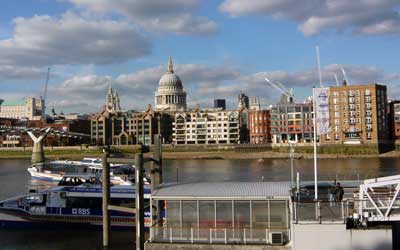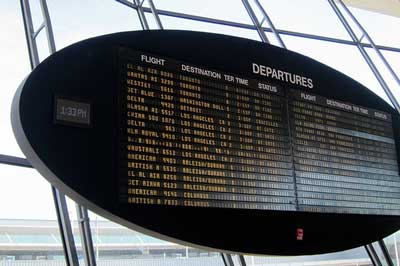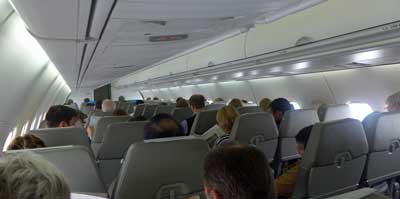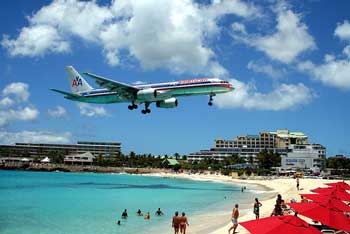Flights are cheapest 5 to 16 weeks out in 2019: Here’s when to book
Trying to find the absolute cheapest airfare for a trip you are planning is like playing a game that feels too easy to lose. Now in this era of ‘big data’ where many companies are able to check airfares on every route every day to calculate the cheapest possible time to buy, it’s finally a bit easier.
Only a few years ago the advice was often to buy between 4 and 6 weeks out, but things have changed and it really depends on where you are going. As you’ll see in the 2019 update below, the window for buying the cheapest fares starts earlier these days and buying about 4 months out often leads to the best deals. We’ve summarized a variety of studies below and with a quick scan you should be able to get some insight on when to buy and when to wait.
Note: This article was first published in 2012, and has been updated and revised each year as new information has come out, most recently in February, 2019.
2019 UPDATE: The data for 2018 has been similar to 2016 and 2017, but it's still complicated
As of 2019 there are quite a few different companies that are analyzing millions of airfare purchases in order to find the money-saving trends. They tend to show the same pattern, which is that buying two or four months early is the sweet spot for most tickets.
For the tests we ran below we used the very helpful tool from Cheapair.com.
Summary: Buying air tickets earlier will usually save you money
In years past the sweet spot for buying cheap tickets often didn’t start until 6 to 8 weeks before the flight, but the data from 2018 shows once again that the cheaper airfares are now usually available starting 4 to 6 months out in many cases. In other words, if you are sure you want to fly on particular dates, you can usually get something close to the lowest possible fare if you book almost half a year out.
Another interesting thing about the data is that once you reach the beginning of that “sweet spot” where fares are near their low for any given flight, they still bounce around by up to US$50 over the next couple of months before they start heading higher as the flight approaches. So the best strategy is to set an alert for fare decreases on the route that you are shopping for, and buy as soon as you get one of those dips.
North America to Europe: 7 to 16 weeks out is usually the sweet spot

As long as you are within that 16-week window, the longer you wait the greater the chance that the fares will start jumping up for good. This is especially true for popular travel periods such as July and August. In spring and autumn you can usually get away with waiting a bit longer.
North America to the Caribbean: Book 3 to 12 weeks out

The Caribbean hurricanes in 2017 won’t change anything, in case you were curious. The islands that were affected most are all small islands that only got a small percentage of Caribbean flights in the first place. The busy airports such as Cancun, Punta Cana, and even San Juan, Puerto Rico (which has fully recovered) should carry on the same as before when it comes to airfare windows.
North America to Asia/Pacific: 8 to 20 weeks is cheapest

The good news is that you no longer have to book so far in advance to get something close to the lowest fare. The more obscure your destination (Hanoi, Kathmandu etc), the earlier you should probably book. For more common destinations such as Tokyo, Singapore, and Bangkok, you have more time to wait.
North America to Middle East & Africa: 6 to 12 weeks is best
Another case where flight shoppers in 2019 can wait a bit longer to get a great deal than even a year ago, you should now be able to get a good fare to a place like Dubai, Abu Dhabi, or Cairo only 6 weeks or so out.
North America to South America: 5 to 16 weeks is cheapest
In 2019 there is a wider range for the lowest fares going from North America to South America. Many of these are not especially popular routes so there isn’t much competition on them. In cases like this it’s usually best to book early because if there is only one airline flying that route, you are vulnerable to a nasty surprise.
On short and popular routes, 3 to 4 weeks is usually fine

Flights within Europe: Buy as early as possible
In reality the cheapest fares within Europe are almost all on the low-cost carriers such as Easyjet and RyanAir. If you are flying on any of those airlines, the fares ALWAYS start out cheap and get more expensive as more seats are sold. So the cheapest time to buy on a low-cost airline is NOW (or as soon as tickets go on sale, which is usually 11 months out).
Flying on a low-cost carrier (even to Europe): Buy now

This is even true on Norwegian Airlines between the US and Europe. They offer the lowest fares in general on scores of popular routes, so if you are sure of your dates you should buy the tickets as soon as possible to lock in the lowest fare. They won’t be getting any cheaper.
Cheapest times of the year to fly
The trends above should be valid for flights for most of 2018 and into 2019, but there are a few times of the year that are always a bit cheaper than others. For this information we look to research from Rick Seaney of FareCompare, who has been doing this longer than anyone else.
Domestic US flights are cheapest
January 7 to March 5 (between Christmas Break and Spring Break)
April 18 to June 2 (between Spring Break and Summer travel season)
August 22 to mid December (most summer trips end and autumn is a slower season)
If you can fly in any of the periods mentioned above you are likely to get lower fares than if you fly during the traditionally busier periods.
US to Europe flights are cheapest
Before June and after mid August (summer season is by far the busiest, and it ends earlier than you might think)
Weekdays and especially Tuesdays and Wednesdays (Even more so than domestic travel, trans-Atlantic travelers like to travel Fridays through Sundays, so flying the other days will almost always be cheaper).
Cheapest time to book flights for Christmas and New Year's trips
According to a 2015 study by Skyscanner, the absolute cheapest time to book flights for the popular dates just before Christmas and New Years is August 10 to 16, at least based on their 2014 data. The study also shows that fares only inch up a bit in later August and into September, but that by early November the fares will be closer to their peak.
Previously we’d heard that it’s best to buy holiday flights as early as possible, which is usually 11 months out for most airlines. I think that’s still mostly true, partly because it will allow you to pick the best possible departure times in both directions. But if you aren’t quite so picky as to which time of day you leave and return, waiting until mid August seems like a decent idea and you’ll still get a relatively good fare.
Important exception: Book flights on low-cost airlines as early as possible, always
If you are thinking about booking a flight on a low-cost airline, such as Southwest or Spirit in the US, or EasyJet or Ryanair in Europe, or Air Asia in Asia, the cheapest fare will always be as early as you are ready to commit. Unlike the more traditional airlines, the low-cost carrier revenue model is based on starting with all seats as cheap as they’ll ever be when the flight is officially in the system. Then as seats are sold on that flight, the fare goes up as the plane is selling out. So maybe the first 20% of the seats are sold at the lowest price, and when those are gone, the next 20% are sold at a higher price, and so forth until all seats are sold or the plane takes off.
However, it’s important to consider the fact that “low-cost airlines” aren’t necessarily cheaper than their more traditional counterparts. Specifically, Southwest Airlines will often be more expensive than American or United, at least once the first group of cheap seats is gone. Also, since traditional airlines do in fact lower fares during the sweet spot of a few weeks to a few months before departure, you might find that waiting for those lower fares might be the best deal of all.
Flights are still often cheapest on Tuesdays and Wednesdays

My favorite trick for finding the best fares for an upcoming flight is to check for that route on a Wednesday and returning on a Wednesday. That will almost always show you the lowest possible fare, and then you can compare prices of other days of the week to see how much more you are willing to pay to fly on, say, a Friday or Saturday.
The advice: Check any and every day of the week, and if it’s the weekend you might want to wait a few more days to see if fares drop.
Why do airfares go up and down and up again as the day approaches?
Looking at the data above, you might think the airlines are playing some sort of game with flyers, but these pricing policies are actually a result of elaborate data and computer models that help them make the most money from each plane that leaves the ground. Here’s why:
People who buy plane tickets early are less price sensitive
In the world of economics they call this being “inelastic” in that in some situations consumers will buy almost exactly as many tickets, even if the price is higher. Airlines (obviously) want to maximize their profit for every seat they sell on the plane, so they take advantage of those who are driven to lock in early.
Consumers who buy early might:
- Already have set vacation days they want to use all of
- Be attending an event, such as a wedding, where there’s no flexibility
- Be someone who feels great stress until the ticket is locked in
In the above situations, whether a round-trip between Los Angeles and London is US$800 or US$1100, the person buying at least 3 months out is likely to buy either way. There is little incentive to airlines to sell a ticket for $800 if they’d sell almost as many at $1100.
People who buy plane tickets late are also less price sensitive
Similarly, consumers who are interested in flying 10 or fewer days from any given moment are also inelastic. They are likely to pay a premium for the convenience of going soon, so there’s little incentive for airlines to discount these tickets either.
Consumers who buy at the last minute might:
- Have just gotten approval for fixed time off soon
- Have an event on a fixed date (a football game, etc)
- Be someone who hates to commit to things early, and is willing to pay extra for the added flexibility
Now, keep in mind, that anyone who is hoping to fly in 10 days or fewer from now will see higher prices, and they’ll have the option of going 2 or 3 weeks later to save quite a bit of money. This price discrimination allows airlines to sell more expensive seats to those who can’t wait, and cheaper tickets to those who can.
What happened to cheap “last-minute” fares?

They tend to offer cheap flights between obscure city pairs on the least popular travel dates. So if you are ready to fly between, say, Charlotte and Bermuda this coming Saturday and return the following Tuesday, those last-minute deals could be for you. But for most of us, they never appear for places we really want to go and at times we want to travel.
Why no last-minute deals, you might ask? Why are airlines willing to fly with empty seats instead of filling them for low prices?
The reason airlines don’t lower prices for unsold seats at the last minute is that the last thing they want to do is condition travelers to wait until the last minute, hoping for a bargain, and then sometimes not flying at all when a bargain doesn’t appear.
Think about it. If you wanted to go from Los Angeles to London at some point soon, and a round-trip next month is $900, but if you go in 2 days it’s only $650, you are likely to buy the cheap ticket two days from now, or skip it and hope that the same deal is available next month when you are ready to go.
Airlines make more money on each plane-load of people if they condition passengers into buying earlier at higher prices, or very early at even higher prices.
When to wait for fare sales

If you are waiting for a fare sale and wondering when it might appear, it’s important to consider the airlines’ motivation in announcing them. Let’s say they announced an October fare sale in June, with round-trip fares way lower than those offered in summer. That would actually cannibalize their business for July through September. If someone is considering paying a high fare to fly in August, the airlines are not motivated to show them a much lower fare if they waited. That would lead to empty seats in late summer, which would be very costly for them.
In almost all cases you are best off waiting until 6 weeks or so before your departure date, but it’s also important to track the fares before that, and keep an eye on fare sales.
This same research by the AP also said that fare sales usually appear on Tuesdays and are over by the end of Thursday, so check fares early in the week and if a price drops then jump on it. They also found the highest fares showed up for those searching on Saturdays and Sundays, so you might be best off just skipping the weekends for fare research anyway.

hello,
May I know when should I buy cheap ticket and how many weeks before I need to book round trip from moscow russia to vienna austria so that I can avail cheap ticket? Do I need a visa or just passport only.
Thank you and God bless. . .
Myra,
For international flights, the cheapest time tends to be about 11 weeks prior to departure. The best thing to do is to check the prices now and check them at least once a week to see if they are going up or down. But if you see a price you can afford within 3 months or so of when you want to leave, just buy it.
For visa and immigration issues, you should check the website of your home government and/or the government of the country you are flying to. Both parts matter, and things tend to change more frequently than you might expect. -Roger
When should I buy a cheap flight to Portugal if
I go this mid December 2013
Kevin,
For international flights, the optimal time is about 11 weeks before your flight, so you are already a bit past that. Also, for flights in the holiday periods, you should buy as early as possible. Mid December isn’t quite yet the holiday, but it’s close, so don’t wait. -Roger
hi, just wanna ask if is possible for my friend to get plane ticket for me she’s in Thailand and I’m here in the Philippines. Can she get a round trip ticket for me there? How will it be? any comments or advised?
Manilyn,
Yes, as long as she uses your name when she buys the ticket, she can buy it from a different country. -Roger
Simplistic answer, far too complex to answer. First of all each departing destination varies. We are blessed with lots of competition and options in New York or London but not si in Manchester or Denver for example. Additionally if you live in the UK and are flying from London the advise to book early, as it will not only apply for Christmas but also the New Year, Easter week, Bank Holiday weeks and/or weekends, all the school summer holiday period especially the weekend before the start of the new school term plus any School term breaks during the year. Fair advice any other time outside these busier periods, but try get a ticket on the busy, non competitive route on British Airways from London to South America(San paulo/Buenos Aires) flight and it all goes pear-shaped, your advice is useless. Or for that matter try getting a flight to South Africa all of DEC or even JAN , where a large SA community living in the UK/London outskirts and is wishing to holiday or returning to visit families and friend – the advice is BOOK EARLY!
Hi can I know how much the price of ticket on feb 29 philippine to india ?
What are best weeks to fly from miami to dublin? Should I search for 1 adult ticket or for 2 adults and 3 kids(that’s what will be flying)
So, what you are saying, If i want to travel by June, which happens to be the peak season, then I would buy the tickets closer to the date that I will travel or do I buy the tickets as early as possible?
aNNA, yes, that’s correct. Except for holidays like Christmas, you’ll usually see the lowest prices 4 to 6 weeks before the flight. The thing is, right now the airlines want to encourage people to fly in February and March, so they don’t slash prices on June flights yet because that would discourage people from flying sooner. -Roger
Great tips, but regarding the 6-4 weeks I think that this applies more for local flights (within the country, or between countries in europe).
My impression is that for intercontinental flights this does not work so well.
Any idea of which sort of flights they evaluated?
Cheers
Thomas, the main research was done by a team of AP reporters, but it’s also been backed up by several other flight experts at various sites. The same market forces are at work whether domestic or international, and I know for sure that if you shop too early for international flights you’ll see higher prices than if you wait until closer to the date. -Roger
About how much is a ticket from chicago to colombia..not columbia COLOMBIA…doesn’t matter how long I gatta wait
my question is if we book tickets 40 days before and cancel it later then how much percentage of amount will be refunded back
Krismohan, the cheapest plane tickets are almost always the non-refundable ones, so unfortunately you don’t get anything back if you change your mind or your plans. -Roger
In answer to Krishmohan’s question, as Roger says, I never find refundable flights at a good price. My solution is to use Southwest whenever possible, especially return flights because I’m constantly changing my mind about my return dates. Southwest doesn’t give free refunds, but they do allow you to change flights with no change fee, and I think you have a year to use it. Since both my husband and parents live in different states from me, I fly enough that I know I will for sure eventually use the ticket. Southwest isn’t the most luxurious airline, but they also offer two free checked bags, and I much prefer them over some other airlines I’ve tried that are not considered “budget.” The drawbacks, I never find red eye flights, which I sometimes prefer, and I rarely find direct flights where I am going. As a side note, Jetblue is my favorite for direct flights, red eye flights, customer service, goodies, and comfort, but alas, they don’t allow free changes. I hope this helps someone.